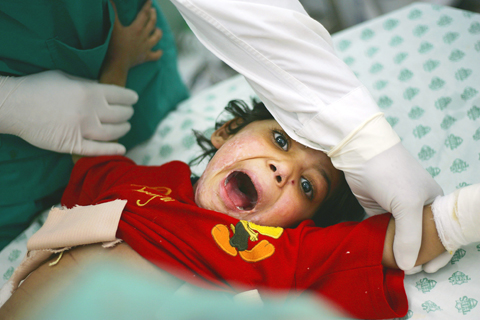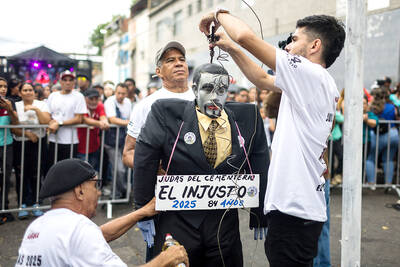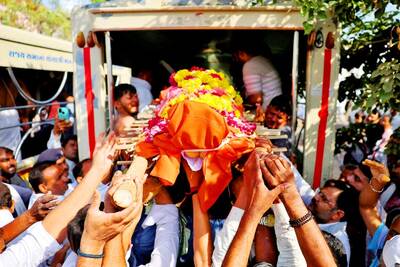Sitting on rubble, using his briefcase as a writing table, human rights researcher Yasser Abdel Ghafar interviewed residents of a house shelled by Israel, part of his assignment to compile detailed lists of killed and wounded during Israel’s 23-day war on Gaza’s Hamas rulers.
His group, the Palestinian Center for Human Rights (PCHR), released a final tally on Wednesday, saying 1,284 Gazans were killed and 4,336 wounded, the majority civilians. Yet Israel, insisting that Hamas is inflating civilian casualties, said it has the names of more than 700 Hamas militants killed in fighting.
The wrangling over the final toll, particularly the ratio of combatants and civilians, is part of the rival Israeli and Palestinian narratives of the Gaza war. Israel portrays it as a justified attempt to finally halt years of indiscriminate Hamas rocket attacks on southern Israel. The Palestinians say it was a brutal onslaught in which troops used disproportionate force in one of the world’s most densely populated areas. Some bombings and shellings of homes, even if targeting militants, killed entire families.

PHOTO: AP
Israeli Defense Minister Ehud Barak said Hamas fighters fired rockets from civilian areas and stored explosives in mosques and schools. Yet he acknowledged that troops “moved forward with fire” to prevent Israeli casualties and that “nobody had any illusions that civilians wouldn’t be harmed as well.”
The growing international outrage over Israel’s offensive has been fueled by the scenes of civilian suffering, including bodies of dead women and children in hospital morgues.
The PCHR said 894 of the dead were civilians, including 280 children and minors, age 17 and under, as well as 111 women. Of the remaining 390 dead, 167 were members of Hamas’ civil police, many of them killed on the job during Israel’s surprise attack on dozens of security compounds.
The civilians not only included innocent bystanders, but also Hamas members killed in non-combat situations, such as Said Siam and Nizar Rayan, two top Hamas leaders assassinated, along with their relatives, in massive bombings of homes, said Ibtissam Zakout, head of the PCHR’s research team.
The rest, or 223, were combatants, she said. That figure is higher than the 158 dead fighters acknowledged by Hamas, Islamic Jihad and other militant groups.
“Maybe they [the militants] were interested to show that they have fewer losses and casualties,” Zakout said.
Others, such as Gaza health ministry official Moawiya Hassanain, have raised the possibility that the militant groups buried some of their fighters in secret, without reporting their deaths.
Zakout said the PCHR count, including the distinction between militants and civilians, is based on cross-checking hospital records and interviews with survivors. The group is affiliated with Geneva-based International Commission of Jurists and has won two European human rights awards.
During the war, 13 Israelis were killed, including three civilians struck by rockets. The other 10 were soldiers.
Israel has not provided its own Palestinian death toll, though Barak said he believed dead militants outnumbered dead civilians.
“Many more than 700 Hamas men were killed, many more,” he told Israel’s Channel 10 TV.
“We know their names,” he said, while noting that civilians were hit as well.
However, Palestinian medics and human rights researchers say they’ve become well-versed in counting casualties during previous conflicts, including two uprisings against Israeli military occupation and internal Palestinian fighting.
A veteran is Hassanain, the health ministry official who has been recording dead and wounded since the start of the second Palestinian uprising in 2000.
Hassanain’s center of operations is a tiny room with furniture he said dates back to pre-1967 Egyptian rule of Gaza. Equipped with just a beeper, a fax, a landline, two mobile phones and a walkie talkie, Hassanain dispatches dozens of ambulances and records the medics’ first reports of dead and wounded on loose sheets of paper.
In between, he accompanies ambulances taking the most seriously wounded to Israel and Egypt.
Hassanain’s handwritten lists, including some stuffed in his jacket pocket, are eventually fed into a clunky old computer by an assistant and transferred to the information center of the health ministry.
The ministry, like most Gaza government agencies, is run by Hamas. Israeli warplanes targeted many Hamas ministries during the war, and the health ministry moved part of its operations to Gaza’s main Shifa Hospital after the start of the offensive.
The ministry’s computer center is fed by faxed reports sent by teams deployed at Gaza’s 20 hospitals and clinics, said statistics chief Samir Radi, who did part of his physician’s training at an Israeli hospital.
The health ministry’s final toll for 23 days of fighting is 1,324 dead and about 5,400 injured — or 40 more dead and about 1,000 more injured than the PCHR.
Radi said names are added to the death toll only after careful consideration, including identification by ID by relatives, particularly if bodies arrive in a dismembered state.
The physician claimed that only about 100 of the dead were combatants, saying he is relying on reports by the militant groups themselves.

POLITICAL PRISONERS VS DEPORTEES: Venezuela’s prosecutor’s office slammed the call by El Salvador’s leader, accusing him of crimes against humanity Salvadoran President Nayib Bukele on Sunday proposed carrying out a prisoner swap with Venezuela, suggesting he would exchange Venezuelan deportees from the US his government has kept imprisoned for what he called “political prisoners” in Venezuela. In a post on X, directed at Venezuelan President Nicolas Maduro, Bukele listed off a number of family members of high-level opposition figures in Venezuela, journalists and activists detained during the South American government’s electoral crackdown last year. “The only reason they are imprisoned is for having opposed you and your electoral fraud,” he wrote to Maduro. “However, I want to propose a humanitarian agreement that

ECONOMIC WORRIES: The ruling PAP faces voters amid concerns that the city-state faces the possibility of a recession and job losses amid Washington’s tariffs Singapore yesterday finalized contestants for its general election on Saturday next week, with the ruling People’s Action Party (PAP) fielding 32 new candidates in the biggest refresh of the party that has ruled the city-state since independence in 1965. The move follows a pledge by Singaporean Prime Minister Lawrence Wong (黃循財), who took office last year and assumed the PAP leadership, to “bring in new blood, new ideas and new energy” to steer the country of 6 million people. His latest shake-up beats that of predecessors Lee Hsien Loong (李顯龍) and Goh Chok Tong (吳作棟), who replaced 24 and 11 politicians respectively

Young women standing idly around a park in Tokyo’s west suggest that a giant statue of Godzilla is not the only attraction for a record number of foreign tourists. Their faces lit by the cold glow of their phones, the women lining Okubo Park are evidence that sex tourism has developed as a dark flipside to the bustling Kabukicho nightlife district. Increasing numbers of foreign men are flocking to the area after seeing videos on social media. One of the women said that the area near Kabukicho, where Godzilla rumbles and belches smoke atop a cinema, has become a “real

‘WATER WARFARE’: A Pakistani official called India’s suspension of a 65-year-old treaty on the sharing of waters from the Indus River ‘a cowardly, illegal move’ Pakistan yesterday canceled visas for Indian nationals, closed its airspace for all Indian-owned or operated airlines, and suspended all trade with India, including to and from any third country. The retaliatory measures follow India’s decision to suspend visas for Pakistani nationals in the aftermath of a deadly attack by shooters in Kashmir that killed 26 people, mostly tourists. The rare attack on civilians shocked and outraged India and prompted calls for action against their country’s archenemy, Pakistan. New Delhi did not publicly produce evidence connecting the attack to its neighbor, but said it had “cross-border” links to Pakistan. Pakistan denied any connection to